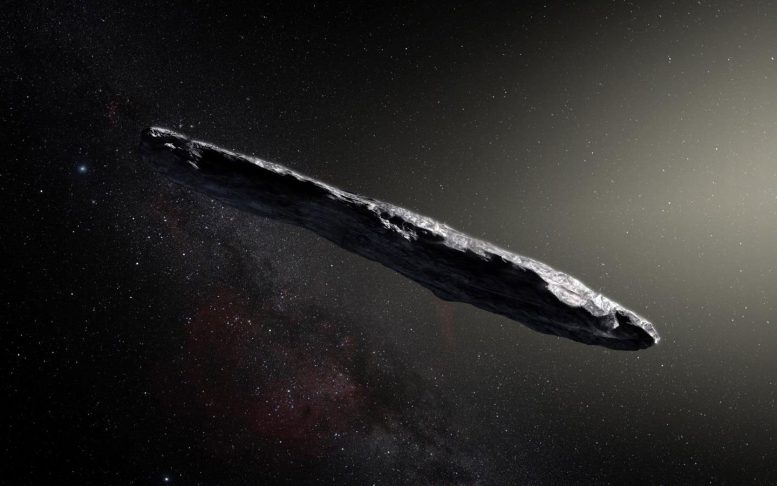
This artist’s impression shows the first interstellar asteroid: `Oumuamua. Credit: ESO/M. Kornmesser
A telescope in outback Western Australia has been used to listen to a mysterious cigar-shaped object that entered our Solar System late last year. The unusual object—known as ‘Oumuamua—came from another solar system, prompting speculation it could be an alien spacecraft.
“So astronomers went back through observations from the Murchison Widefield Array (MWA) telescope to check for radio transmissions coming from the object between the frequencies of 72 and 102MHz —similar to the frequency range in which FM radio is broadcast.
While they did not find any signs of intelligent life, the research helped expand the search for extra-terrestrial intelligence (SETI) from distant stars to objects closer to home.
When ‘Oumuamua was first discovered, astronomers thought it was a comet or an asteroid from within the Solar System. But after studying its orbit and discovering its long, cylindrical shape, they realized ‘Oumuamua was neither and had come from interstellar space.
For the first time ever astronomers have studied an asteroid that has entered the Solar System from interstellar space. Observations from ESO’s Very Large Telescope in Chile and other observatories around the world show that this unique object was traveling through space for millions of years before its chance encounter with our star system. It appears to be a dark, reddish, highly-elongated rocky or high-metal-content object.
Telescopes around the world trained their gaze on the mysterious visitor in an effort to learn as much as possible before it headed back out of the Solar System, becoming too faint to observe in detail.
John Curtin Distinguished Professor Steven Tingay, from the Curtin University node of the International Center for Radio Astronomy Research (ICRAR), said the MWA team did not initially set out to find ‘Oumuamua.
This animation shows the path of the interstellar asteroid 1I/2017 (`Oumuamua) through the Solar System. Observations with ESO’s Very Large Telescope and others have shown that this unique object is dark, reddish in color and highly elongated.
“We didn’t set out to observe this object with the MWA but because we can see such a large fraction of the sky at once, when something like this happens, we’re able to go back through the data and analyze it after the fact,” Professor Tingay said.
“If advanced civilizations do exist elsewhere in our galaxy, we can speculate that they might develop the capability to launch spacecraft over interstellar distances and that these spacecraft may use radio waves to communicate.”
“Whilst the possibility of this is extremely low, possibly even zero, as scientists it’s important that we avoid complacency and examine observations and evidence without bias.”
The MWA is located in Western Australia’s remote Murchison region, one of the most radio quiet areas on the planet and far from human activity and radio interference caused by technology.
It is made up of thousands of antennas attached to hundreds of “tiles” that dot the ancient landscape, relentlessly observing the heavens day after day, night after night.
Professor Tingay said the research team was able to look back through all of the MWA’s observations from November, December and early January, when ‘Oumuamua was between 95 million and 590 million kilometers from Earth.
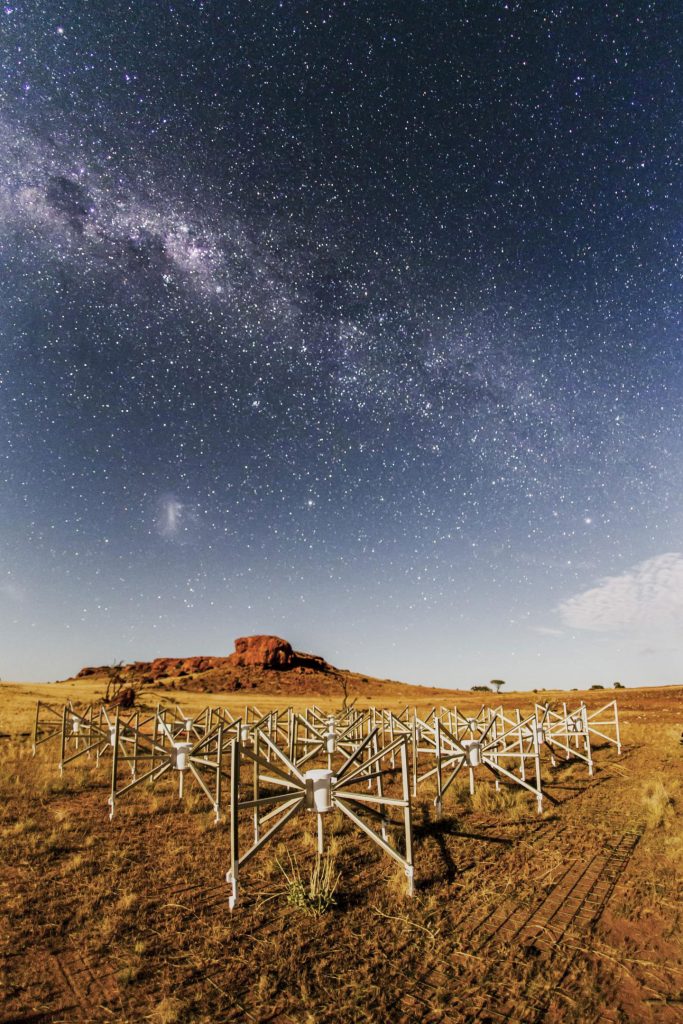
Tile 107, or “the Outlier” as it is known, is one of 128 original tiles of this SKA precursor instrument located 1.5km from the core of the telescope. Lighting the tile and the ancient landscape is the Moon. Credit: Photographed by Pete Wheeler, ICRAR.
“We found nothing, but as the first object of its class to be discovered, `Oumuamua has given us an interesting opportunity to expand the search for extra-terrestrial intelligence from traditional targets such as stars and galaxies to objects that are much closer to Earth.
“This also allows for searches for transmitters that are many orders of magnitude less powerful than those that would be detectable from a planet orbiting even the most nearby stars.”
‘Oumuamua was first discovered by the Pan-STARRS project at the University of Hawaii in October.
Its name loosely means “a messenger that reaches out from the distant past” in Hawaiian, and is the first known interstellar object to pass through our Solar System.
Combining observations from a host of telescopes, scientists have determined that `Oumuamua is most likely a cometary fragment that has lost much of its surface water because it was bombarded by cosmic rays on its long journey through interstellar space.
Researchers have now suggested there could be more than 46 million similar interstellar objects crossing the Solar System every year.
While most of these objects are too far away to study with current technologies, future telescopes such as the Square Kilometer Array (SKA) will enable scientists to understand more about these interstellar interlopers.
“So once the SKA is online, we’ll be able to look at large numbers of objects and partially balance out the low probability of a positive detection.”
Reference: “A Serendipitous MWA Search for Narrowband Signals from ‘Oumuamua” by S. J. Tingay, D. L. Kaplan, E. Lenc, S. Croft, B. McKinley, A. Beardsley, B. Crosse, D. Emrich, T. M. O. Franzen, B. M. Gaensler, L. Horsley, M. Johnston-Hollitt, D. Kenney, M. F. Morales, D. Pallot, K. Steele, C. M. Trott, M. Walker, R. B. Wayth, A. Williams and C. Wu, 9 April 2018, The Astrophysical Journal.
DOI: 10.3847/1538-4357/aab359

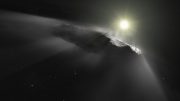
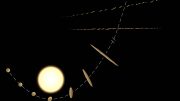
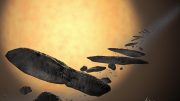
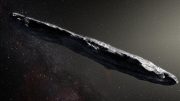


This object did not respond to astronomers radio transmission.
If there is aliens controlling his object, they might not communicate with radio.
They may have a communication method that is unknown to astronomers.
You make a good point, james carter.